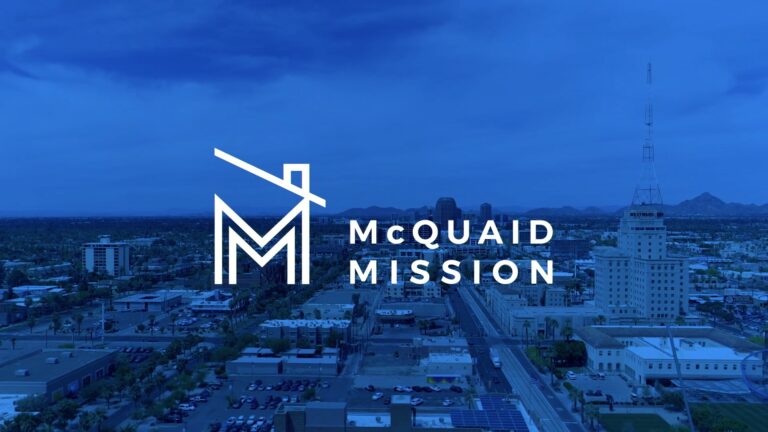Kristen Keogh, Host
McQuaid Mission Episode 7 Highlights
Over 11,000 Arizona residents are homeless.
Every other week we dedicate a full episode to the news, progress and innovations surrounding homelessness in Phoenix with our McQuaid Mission series.
This week’s episode explores how technology could transform the way Arizonans receive aid and why it‘s important to understand the difference between homelessness and poverty.
Read the highlights from Episode 7 of the McQuaid Mission below.
For me, I see a parallel to the business side. Where you have legacy systems and processes that hold you back from being able to do things better and more efficiently, and more effectively.
Jon Ehlinger, President, Garcia Family Foundation
Data Systems as Community Resources
According to John Ehlinger, President of the Garcia Family Foundation, data and analytics can be “transformative” to reducing homeless populations. Systems and technology can bring organizations together to better identify what people need and how to find the right solutions.
Ehlinger explains that data has shown how the current system would be more effective by shifting from a “provider” focus to a “client” focus. Data has also provided the solution to reorganizing how the current system would operate and distribute services.
Most homeless people need help with multiple issues. Employment, health care, food and shelter are just some of the many areas of need. Those who need help may reach out to a mix of organizations for aid. Some organizations may only offer one service, others may offer a few. This creates overlap.
The challenge is that there is no master database that organizations can cross-check to view a client’s full history, to see what type of services they receive and what they have or haven’t tried. The data is detached between organizations.
But, according to Ehlinger, using data to flip that system would radically improve the effectiveness of how homeless populations are helped. Data systems present the opportunity for organizations to share data and collaborate.
This was huge. It gave me a boost of confidence that I could start over, that I could follow a different path and succeed at the things I want to do.
Kyle Johnson, Survivor
Arizona Homelessness Success Story
In this episode homelessness and suicide survivor, Kyle Johnson tells his story. Growing up as an athlete in an upper-middle-class family, homelessness was not a possibility Johnson considered. But, after a chain of what he describes as “bad” choices, he found himself without a home. Johnson decided to kill himself, but with the help of a neighbor, Banner Health and the Human Services Campus, he was able to regain a life he thought he had lost.
Local Leader to Leader Q&A
Q: Do we have enough resources to treat what is often the cause of those experiencing homelessness? We know that those who do experience homelessness may have mental health issues that have not been treated. How can we better support them and provide resources to treat the cause, not just the symptoms?
Monica Villalobos, President and CEO, Arizona Hispanic Chamber of Commerce
A: We know at the Human Services Campus that 40% of people who come to us for services self report a mental health issue as a barrier to housing stability. . . We need help looking at the resources that our system does have at the state level, the federal level, funding that comes to us. . . Can we get the right resource to the right people at the right time? It is an underserved population in our community and we could certainly use all of the help we can have from the business community to help us advocate for that different alignment of resources.
Amy Schwabenlender, Executive Director, Human Services Campus
When you really think about it, everybody has had their circumstances of bad luck. But many people have had support systems and other aspects of opportunity to allow them to maintain themselves despite the bad luck. Some haven’t, and that’s one of the main reasons for homelessness.
Jerry Hirsch, Chairman, The Lodestar Foundation
Homelessness vs. Poverty
Homelessness and poverty are often lumped together, but they’re not the same thing. Homelessness is considered to be a temporary problem, whereas poverty is often a chronic condition. Not everyone who experiences poverty will necessarily become homeless. Not everyone who becomes homeless at some point in their life is destined for a life of poverty.
Separating these concepts changes how organizations approach solutions. Even though homelessness is far from an “easy” problem to fix, assisting someone during a temporary moment of need is simpler than trying to solve a systemic issue. But, it all comes back to having access to the right resources at the right time.
When homelessness is looked at through Hirsch’s lens of circumstantial “bad luck” the problem becomes more practical.
Homelessness Mythbusters
Myth: Homeless Arizona residents travel to cooler climates like Flagstaff during hot weather months
It's been studied, it's been surveyed locally, there have been efforts during the summer to count and survey people. . . The data isn't there to demonstrate any kind of dramatic movement of people from Phoenix to Flagstaff, or vice versa during the winter. . . Sadly, we have the same number of people experiencing homelessness here in Phoenix almost every single day of the year.
Amy Schwabenlender, Executive Director, Human Services Campus Tweet



